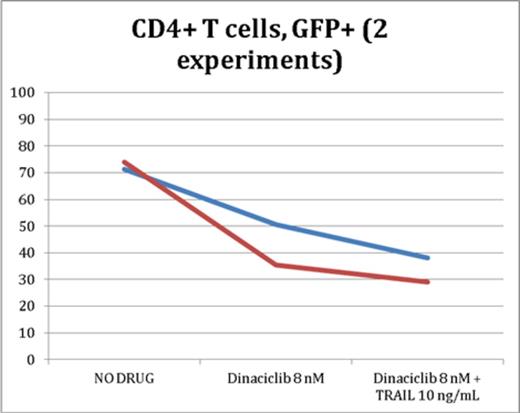Abstract
Background:
Reactivation of HIV from latently infected T cells with oncologic agents (such as vorinostat) has been proposed as a means to potentially reduce or eliminate the HIV reservoir. A CDK9 inhibitor used in hematologic malignancies, flavopiridol, has previously been shown to selectively kill HIV infected cell lines and in addition, CDK9 inhibition was shown to synergize with TRAIL in killing cervical cancer and non-small cell lung cancer lines.
Aims:
Here we aim to show that, in in vitro assays, that the CDK9 inhibitors, Flavopiridol and Dinaciclib, can selectively kill HIV infected cell lines, and primary infected CD4+ T cells. We also wish to explore potential synergy with TRAIL to kill cervical cancer lines, HIV infected cell lines, and also selectively kill CD4+ T cells infected with HIV in vitro.
Methods:
For cell line experiments, the CEM leukemia cell line, and the ACH2 cell line, (CEM cells with 2 integrated copies of HIV) were used. For one experiment, cells were incubated with either Flavopiridol (75nM) [F] or Dinaciclib (10 nM) [D] for 14 hr. Separately, the duration of drug exposure was extended to 54 hrs, with 1.4 million cells/mL for each cell line. Cells had drug alone, drug with TRAIL (1 hr after drug) at a concentration of 10 ng/mL or TRAIL alone.
For cervical cancer line experiments, HeLa cells were used (HEK cells were control). Cells were incubated with Dinaciclib (12.5 nM) [D] for 24 hrs. TRAIL was added one hr after D was applied.
For primary CD4+ T cell infections, PBMCs were obtained from healthy donors, CD4s were isolated, and infected with a GFP containing virus (MOI ~0.1). Cells which expressed GFP actively produced virus, while cells without GFP expression did not. GFP+, GFP- and mock infected CD4+ T cells were exposed to D for 20 hrs. In another experiment cells were also exposed to D and TRAIL 1 hr after D was applied.
Results:
The ACH2 line had a survival (assessed as VIVID and Annexin negative cells) of 93% on avg and the CEM line 90% with no drug after 14 hr of culture. With Dinaciclib [D], viability decreased to 58% in ACH2 cells, but remained at 80% in CEM cells (p<0.05). Flavopiridol [F] did not cause significant decline in viability. After 54 hrs of exposure, D, and F+ TRAIL showed marked declines in cell number (see Table 1). Surprisingly, the CEM line had marked declines with TRAIL alone, but the ACH2 line was resistant to TRAIL alone.
HeLa cells showed marked decrease in viability (via XTT assay) with synergy between D and TRAIL. With 24 hrs of D (12.5 nM) exposure HeLa viability decreased with an OD from 1.65 to 1.19 (28% decrease). With D and TRAIL (10 ng/mL), viability decreased with an OD from 1.65 to 0.67 (59% decrease, p<0.05). HEK cells showed no significant decrease.
GFP+ infected T cells showed a decrease in viability from 66% to 32.2% after 20 hrs of Dinaciclib exposure (8 nM), see Fig. 1, error bars shown. GFP- T cells showed no significant difference in viability (90.2 to 82.2%) and MOCK infected T cells showed no significant difference in viability (87.3 to 78.3%). In 2 donors, TRAIL was added to Dinaciclib which resulted in further decreases in viability (mean 72.7% viable to 43% with D and to 33.6% with D and TRAIL)
Conclusions:
CDK9 inhibition shows promise as a strategy for both cervical cancer treatment and HIV reservoir modulation. Combining CDK9 inhibition with TRAIL also shows potential. Interestingly, it is also possible that HIV integration may play a novel role in TRAIL resistance. Further work is needed to further elucidate the details of the prospective death pathways involved.
Viability of Infected CD4+ T cells - 20 hr exposure
54 Hour Experiment – Cell lines
| Cell Type . | Starting Concentration . | Final Concentration . | Cell Type . | Starting Concentration . | Final Concentration . |
|---|---|---|---|---|---|
| ACH2 alone | 1.4 million | 4.05 million | CEM alone | 1.4 million | 3.37 million |
| ACH2 + Dinaciclib (10 nM) | 1.4 million | 780,000 | CEM + Dinaciclib (10 nM) | 1.4 million | 2.2 million |
| ACH2 + Flavopiridol (75 nM) | 1.4 million | 2.8 million | CEM + Flavopiridol (75 nM) | 1.4 million | 2.36 million |
| ACH2+ TRAIL (10 ng/mL) | 1.4 million | 3.71 million | CEM + TRAIL (10 ng/mL) | 1.4 million | 730,000 |
| ACH2+ Flavopiridol (75 nM) + TRAIL (10 ng/mL) | 1.4 million | 940,000 | CEM+Flavopiridol (75 nM) + TRAIL (10 ng/mL) | 1.4 million | 1.79 million |
| Cell Type . | Starting Concentration . | Final Concentration . | Cell Type . | Starting Concentration . | Final Concentration . |
|---|---|---|---|---|---|
| ACH2 alone | 1.4 million | 4.05 million | CEM alone | 1.4 million | 3.37 million |
| ACH2 + Dinaciclib (10 nM) | 1.4 million | 780,000 | CEM + Dinaciclib (10 nM) | 1.4 million | 2.2 million |
| ACH2 + Flavopiridol (75 nM) | 1.4 million | 2.8 million | CEM + Flavopiridol (75 nM) | 1.4 million | 2.36 million |
| ACH2+ TRAIL (10 ng/mL) | 1.4 million | 3.71 million | CEM + TRAIL (10 ng/mL) | 1.4 million | 730,000 |
| ACH2+ Flavopiridol (75 nM) + TRAIL (10 ng/mL) | 1.4 million | 940,000 | CEM+Flavopiridol (75 nM) + TRAIL (10 ng/mL) | 1.4 million | 1.79 million |
No relevant conflicts of interest to declare.
Author notes
Asterisk with author names denotes non-ASH members.



This feature is available to Subscribers Only
Sign In or Create an Account Close Modal